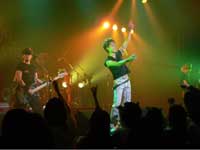
Yuji Sasaki (center) performing and appealing for peace.

縲Yuji Sasaki, 37, the vocalist of the rock band 窶廨od Breath,窶・sings songs about his aunt, Sadako, to express the importance of peace. Sadako Sasaki was the girl who served as the inspiration for the Children窶冱 Peace Monument.
縲Sadako was two years old when Hiroshima was attacked, and though she survived the bombing, she later died of leukemia in 1955. Hoping to overcome her illness, Sadako had folded hundreds of paper cranes until her death at the age of 12. (An old belief in Japan says that paper cranes can make wishes come true.) As a child, Yuji heard her story from his grandparents and, through his music, he wants to continue sharing her life with the world.
縲He performs in concerts and at peace events throughout Japan and he also plays his music at schools. From the stage, he tells Sadako窶冱 story and he urges students to 窶彡herish your life窶・ This is the message he now hands down from his aunt who died so young. (Ryu Kanchika, 17)
縲Mitsunori Yagawa, 55, a piano tuner from Hiroshima, owns three pianos that survived the atomic bomb. In 2005, for the 60th anniversary of the bombing, he initiated a concert tour with these pianos and, so far, more than 180 concerts have been held throughout Japan.
縲In May, Mr. Yagawa hosted a concert in Hiroshima with a piano that had been located just 1.8 kilometers from the hypocenter. The pianist was Miwa Yokoyama, 23, and her performance was accompanied by a reading that related the story of the piano窶冱 history. Ms. Yokoyama was impressed with the piano and remarked, 窶弋he sound was so light-it was hard to believe it had been through the bombing.窶・/p>
縲The surface of the piano, though, suffered many scratches as a result of flying glass and debris. But Mr. Yagawa believes it best not to repair the instrument窶冱 appearance so its true impact from the bombing can be seen.
縲After a concert, he invites the audience to touch the piano and feel its scars. He hopes 窶忱oung people can reflect on the atomic bomb by listening to these pianos and touching them窶・ (Ryu Kanchika, 17)
縲In the basement of a broken building, a baby was born, but the midwife who helped deliver the baby died soon after窶ヲ This is the story told in poet Sadako Kurihara窶冱 masterpiece 窶弩e Shall Bring Forth New Life窶・ In May, a song based on this poem was sung in Peace Memorial Cathedral in Hiroshima.
縲The song was composed by Yukitake Nakamura, 63, who was a friend of the poet while she was alive. He composed this 10-minute piece for the Czech Girls Choir 窶廱itro窶・ who visited Japan on a 窶徼our of peace窶・ The song began in a darker mood, but the girls窶・voices gradually sang out with hope. 窶廱itro窶・will sing this song in countries around the world.
縲A kokarina is a wooden ocarina. The kokarina musician, Kurotaro Kurosaka, has made eight kokarinas from a tree that survived the atomic bomb. He says, 窶廬t produces a clear, beautiful sound. I can feel the tree窶冱 power-the power that overcame the hardship of the bombing.窶・/p>
縲That tree was a hackberry which was standing in the garden of the army hospital, in the city center, when Hiroshima was bombed. Although it was terribly burnt, it still stood as a silent witness to the bombing until it fell from a typhoon in 1984.
縲Mr. Kuroda plays his original song 窶彜ky窶・on this kokarina. The song窶冱 lively melody was inspired by the tree窶冱 vitality.
縲The Hiroshima Traditional Japanese Music Association is composed of musicians living in Hiroshima who play the koto and the bamboo flute. Through their concerts, they appeal for peace both inside and outside Japan. In 2005, they performed at the United Nations Office in Geneva, Switzerland and, in 1995, they held a concert at the United Nations Headquarters in New York.
縲These concerts were realized as a result of the efforts of the Association窶冱 President, Tomoko Fukumori.
縲The Hiroshima Boys Choir was founded in 1960. Currently, 42 boys from the Hiroshima area, of all ages, take part in this choir. They perform regularly in local and international concerts.
縲In their repertoire, they have many peace-related songs, such as 窶廰et窶冱 Give Flowers窶・ Through these songs, they try to share the heart of Hiroshima. One member, Tomonori Osedo, 10, said, 窶廣s I sing, I窶冦 thinking about the meaning of the songs and sending a message of peace.窶・/p>